

2/2006
AIA QUARTERLY
HOME DESIGN SURVEY
Residential Architects Report Strong Design Focus on Kitchens and Baths
Larger sizes, greater numbers, upscale features
grow in popularity

by Kermit Baker,
PhD, Hon. AIA
Chief Economist
Kitchens and bathrooms traditionally have been the areas in homes that get the most design attention. This trend is unlikely to change anytime soon. More than 40 percent of residential architecture firms participating in the AIA Home Design Survey indicate that the size of kitchens, as well as the size and number of bathrooms are increasing in U.S. homes. Moreover, a quarter of these firms indicate that even the number of kitchens is increasing in homes, when “kitchens” are defined as separate kitchen facilities or secondary food storage or food preparation areas.
With the added attention on kitchens and baths, residential architects report added features, with kitchens having more pantry space, more upper-end appliances, and increased integration with family space for younger children and other family members as kitchens have become the focal point in many homes. With more space, bathrooms likewise have more features and typically include more upscale products such as multi-head showers, hand showers, and even steam showers.
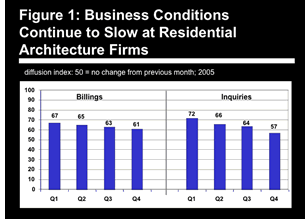 Easing in business conditions continues at residential design firms
Easing in business conditions continues at residential design firms
Last year was a phenomenal year for residential construction: More than
2.06 million homes were started, the best performance for the industry
since 1972. This includes 1.71 million single-family housing starts,
the largest number ever in that category. Still, there are signs that
the home building market is beginning to ease. The AIA Home Design
Survey billings index fell every quarter in 2005. Even though almost
three times as many residential architecture firms report that billings
at their firms increased during the quarter as reported that their
billings declined (34 percent vs. 12 percent), these firms are reporting
an easing in the pace of growth. A telling sign is that a separate
indicator of inquiries to firms for new projects has seen a fairly
steep decline over the course of the year, pointing to even slower
growth in firm billings in the quarters ahead.
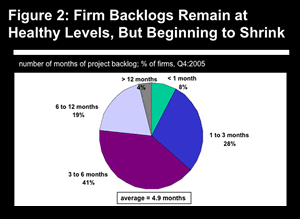 Another
indication of slowing activity at residential architecture firms is the
decline in project backlogs. Firms currently report an average of 4.9
months of backlog (the amount of time needed to complete current projects
at current staffing levels), down from the third quarter figure of 5.2
months. Still, almost two-thirds of participating firms report at least
three months of project backlogs, and almost a quarter reports at least
six months.
Another
indication of slowing activity at residential architecture firms is the
decline in project backlogs. Firms currently report an average of 4.9
months of backlog (the amount of time needed to complete current projects
at current staffing levels), down from the third quarter figure of 5.2
months. Still, almost two-thirds of participating firms report at least
three months of project backlogs, and almost a quarter reports at least
six months.
Several residential market sectors seen as weakening
Members of the AIA Home Design Survey are asked to report on the health
of the residential segments that they serve. The two remodeling sectors
covered—additions and alterations to existing homes and kitchen
and bath remodeling projects—both are reported to be very healthy
at present. The townhouse/condo segment, which historically has been
very volatile, remained reasonably strong in the fourth quarter, although
the growth rate was slowing from earlier in the year.
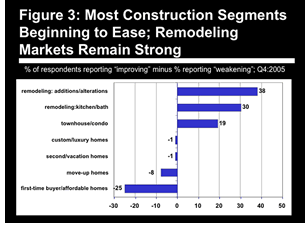 However,
many of the construction sectors were reported to be flat or weakening
in the fourth quarter. Fully as many residential architecture firms reported
the custom/luxury homes and second/vacation homes segments to be weakening
as reported them to be strengthening. More firms reported the move-up
housing sector as weakening than strengthening, and many more (36 percent
vs. 12 percent) reported the first-time buyer/affordable housing sector
to be to be weakening as compared to those reporting it as strengthening.
Some of this slowdown may be merely seasonal, since the fourth quarter
of the year is typically a slow time for design and construction activity.
However,
many of the construction sectors were reported to be flat or weakening
in the fourth quarter. Fully as many residential architecture firms reported
the custom/luxury homes and second/vacation homes segments to be weakening
as reported them to be strengthening. More firms reported the move-up
housing sector as weakening than strengthening, and many more (36 percent
vs. 12 percent) reported the first-time buyer/affordable housing sector
to be to be weakening as compared to those reporting it as strengthening.
Some of this slowdown may be merely seasonal, since the fourth quarter
of the year is typically a slow time for design and construction activity.
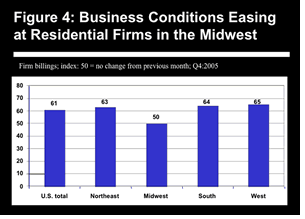 Despite
an easing in billings nationally at residential architecture firms, firms
in most regions are reporting reasonably healthy business conditions.
The exception is the Midwest, where as many firms reported declining
billings as reported gains. In the Northeast, firms reported further
improvement in business conditions in the fourth quarter relative to
the third.
Despite
an easing in billings nationally at residential architecture firms, firms
in most regions are reporting reasonably healthy business conditions.
The exception is the Midwest, where as many firms reported declining
billings as reported gains. In the Northeast, firms reported further
improvement in business conditions in the fourth quarter relative to
the third.
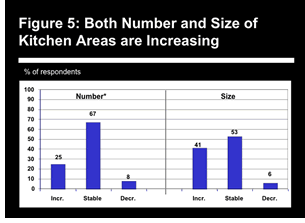 Larger kitchens allow for more features
Larger kitchens allow for more features
Kitchens are not only increasing in size according to survey respondents,
kitchen functions are spreading throughout the house and into the yard.
A quarter of respondents to the AIA Home Design Survey reported that
the number of “kitchens” in the home is increasing. These
may be separate cooking facilities in an in-law or au pair suite; secondary
food storage or food preparation areas in the home; or they may be
outdoor kitchens, a feature that is increasingly popular in many areas
of the country.
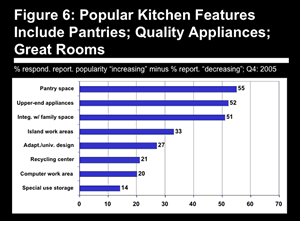 As
kitchens grow in size, households are adding more and more features.
At the top of the list is added pantry space, followed closely by increased
popularity of upper-end appliances. Residential architects also report
that kitchens are becoming more integrated into living areas of the home
by adding family space onto kitchen areas, adding work stations/work
areas, and generally making them more accessible to other areas in the
home.
As
kitchens grow in size, households are adding more and more features.
At the top of the list is added pantry space, followed closely by increased
popularity of upper-end appliances. Residential architects also report
that kitchens are becoming more integrated into living areas of the home
by adding family space onto kitchen areas, adding work stations/work
areas, and generally making them more accessible to other areas in the
home.
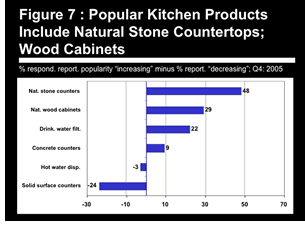 Given
the extra attention being given to kitchens, there is added focus on
products used. Countertops are increasingly a fashion area in kitchens,
and panelists report that natural stone is significantly increasing in
popularity, concrete (or other nontraditional material) countertops have
caught on only to a limited degree, while synthetic solid-surface countertops
are declining in popularity according to many members of our panel. Natural
wood cabinets and drinking water filtration systems are also increasing
in popularity.
Given
the extra attention being given to kitchens, there is added focus on
products used. Countertops are increasingly a fashion area in kitchens,
and panelists report that natural stone is significantly increasing in
popularity, concrete (or other nontraditional material) countertops have
caught on only to a limited degree, while synthetic solid-surface countertops
are declining in popularity according to many members of our panel. Natural
wood cabinets and drinking water filtration systems are also increasing
in popularity.
 Bathrooms keep increasing in number and size
Bathrooms keep increasing in number and size
Even more so than kitchens, households continue to want more and larger
bathrooms in their homes. More than 40 percent of residential architects
report that the number of bathrooms in homes is increasing, and an
even larger share report that they are getting larger. Hardly any report
decreases in the number or size of bathrooms.
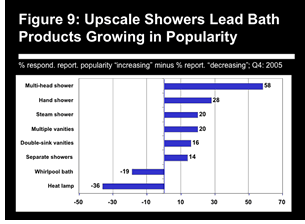 More
upscale showers are one area of change: residential architects report
more multi-head showers, hand showers, steam showers, and separate (his
and her) showers. In an effort to increase accessibility, walk-in showers
without doors are increasing in popularity. To allow separate use, double-sink
vanities or multiple vanities are more popular. Although most respondents
indicate that heat lamps are becoming less popular in bathrooms, many
respondents indicated that radiant heated floors, heated towel racks,
towel-warming drawers, or even fireplaces in bathrooms are features that
are becoming more common.
More
upscale showers are one area of change: residential architects report
more multi-head showers, hand showers, steam showers, and separate (his
and her) showers. In an effort to increase accessibility, walk-in showers
without doors are increasing in popularity. To allow separate use, double-sink
vanities or multiple vanities are more popular. Although most respondents
indicate that heat lamps are becoming less popular in bathrooms, many
respondents indicated that radiant heated floors, heated towel racks,
towel-warming drawers, or even fireplaces in bathrooms are features that
are becoming more common.
Copyright 2006 The American Institute of Architects.
All rights reserved. Home Page ![]()
![]()
The AIA Home Design Trends Survey is conducted quarterly by the AIA. Because residential architects are design leaders in shaping how homes function, look, and integrate into communities, this survey helps to identify emerging trends in the residential marketplace. It also monitors business conditions at residential architecture firms. For more information on this survey, contact Scott Frank, director of AIA media relations.
![]()